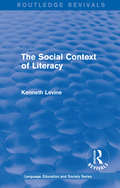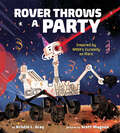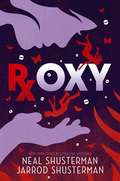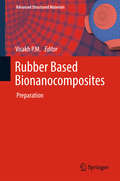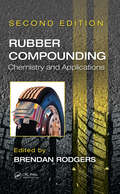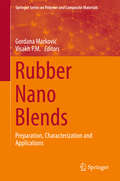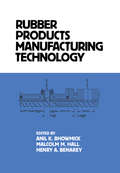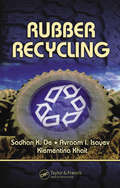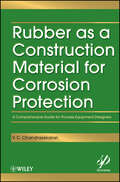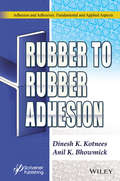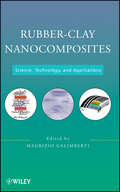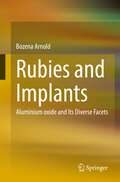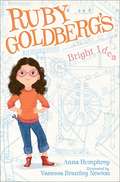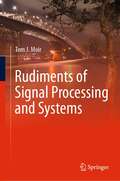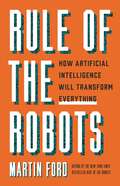- Table View
- List View
Routledge Revivals: Agriculture in France on the Eve of the Railway Age (Routledge Revivals)
by Hugh CloutFirst published in 1980, this compact and useful book uses the earliest volumes of government-published statistics, and with the aid of computer-generated cartography, transforms the numbers there reported into an arrondissement-by-arrondissement comparative picture of French agriculture in the mid-1830s. Clout reviews problems of rapid population growth, scarcely adequate domestic food supplies and primitive systems of transportation, while attention is drawn to spatial variations in agricultural activity and productivity. Commercial, high-yielding farming was best developed in a northern multi-nuclear region, comprising of Ile-de-France, Normandy and Nord, with smaller foci of commercial orientation along an eastern axis from Alsace to Marseilles and in western areas from the Loire to the middle of the Garonne valley. Clout concludes that the revolutionary promise of national economic unity was far from being realised in the 1830s and was not to be achieved until national systems of transport and education were firmly established later in the nineteenth century.
Routledge Revivals: The Social Context of Literacy (Routledge Revivals: Language, Education and Society Series #1)
by Kenneth LevineFirst published in 1986, this book looks at the impact of mass literacy on everyday life, discussing the fundamental differences between traditional oral cultures and contemporary industrialised societies where most people rely on complex combinations of oral and literate communication. There is also a detailed examination of the problems of the sub-literate minority with recommendations for future programmes of assistance. This book also provides a historical survey of the spread of literacy in British society from the Roman occupation onwards. In conclusion, the author discusses the impact of information technologies on people with limited basic skills.
Rover Throws a Party: Inspired by NASA's Curiosity on Mars
by Kristin L. GrayInspired by NASA's Curiosity rover, this is the story of a lonely Mars rover who plans the best birthday party in the solar system.It's Rover's anniversary on Mars! Time to celebrate by throwing the best party this planet has ever seen. Rover hands out invitations all over town, but it seems like he's the only one around. Will anyone come to the party, or will Rover be all alone on his big day? In 2013, NASA programmed their Curiosity rover to hum "Happy Birthday to You" in honor of its first year on Mars. Inspired by this anecdote, this is the tale of a lonely rover and his party, accompanied by fascinating Mars rover facts that help explain the real science behind the story. This fun birthday tale provides an accessible, kid-friendly look at one of NASA's coolest programs.
Rowing Biomechanics and Hydrodynamics: Performance Enhancement Through Sport Engineering (Series in BioEngineering)
by Muhamad Noor Harun Ardiyansyah Syahrom Ab Aziz Mohd YusofThis book introduces engineering principles into the sport of rowing by the integration of rower biomechanics, stroke style, and blade hydrodynamics to improve the rowing performance in the sport. The book starts with an essential overview of rowing, covering its history, governing organizations, and the stroke phases. It looks into the biomechanical and hydrodynamic aspects, emphasizing different body segments and stroke styles contributing to rower performance. Key performance parameters are discussed, such as peak force, stroke rate, and hydrodynamic force. It also highlights the utilization of dynamic rowing simulators and specialized sensors to collect crucial performance assessment and improvement data. By addressing the engineering aspects of the sport, the book offers the potential for performance enhancement, ultimately benefiting the rowing community and advancing sports science.
Roxy
by Neal Shusterman Jarrod ShustermanFrom the team that brought you the New York Times bestselling Dry comes a &“gritty and unflinching&” (Booklist) thriller that proves when gods play games, even love is a lie.The freeway is coming. It will cut the neighborhood in two. Construction has already started, pushing toward this corridor of condemned houses and cracked concrete with the momentum of the inevitable. Yet there you are, in the fifth house on the left, fighting for your life. Ramey, I. The victim of the bet between two manufactured gods: the seductive and lethal Roxy (Oxycontin), who is at the top of her game, and the smart, high-achieving Addison (Adderall), who is tired of being the helpful one, and longs for a more dangerous, less wholesome image. The wager—a contest to see who can bring their mark to &“the Party&” first—is a race to the bottom of a rave that has raged since the beginning of time. And you are only human, dazzled by the lights and music. Drawn by what the drugs offer—tempted to take that step past helpful to harmful…and the troubled places that lie beyond. But there are two I. Rameys—Isaac, a soccer player thrown into Roxy&’s orbit by a bad fall and a bad doctor and Ivy, his older sister, whose increasing frustration with her untreated ADHD leads her to renew her acquaintance with Addy. Which one are you?
Rubber Based Bionanocomposites
by Visakh P. M.Leading researchers from industry, academy, government and private research institutions across the globe have contributed to this book, which presents all types of rubber blend composites based on biomaterials as well as nanocomposites. It discusses the fundamental preparation methods of these materials and summarizes many of the latest technical research advances, offering an essential guide for academics, researchers, scientists, engineers and students alike.
Rubber Based Bionanocomposites: Applications (Advanced Structured Materials #227)
by P. M. VisakhThis book emphasizes on the various aspects of applications of rubber-based bionanocomposites. It summarizes in a comprehensive manner many of the recent research advances in the rubber-based bionanocomposites and their applications, such as biomedical packaging, structural applications, military applications, tire industry, and coating industry of different bionanocomposites of cellulose rubber, chitin rubber, starch rubber, soy protein rubber, PLA rubber, hemi cellulose rubber-based bionanocomposites. This book also discusses PHA-based rubber composites which covers an up to date record on the major findings and observations in the field of applications of rubber based bionanocomposites. This book serves as a “one stop” reference resource for important research accomplishments in the above area. Academics, researchers, scientists, rubber technologist, biotechnologist, and students in research and development will benefit from an application-oriented book that helps them to find solutions to both fundamental and applied problems.
Rubber Based Bionanocomposites: Characterisation (Advanced Structured Materials #210)
by Visakh P. M.This book presents detailed insights into the characterization of bionanocomposite materials based on rubber. Examining various classes of material bases, such as cellulose, chitin, starch, soy proteins, polylactic acid (PLA), bacterial cellulose and casein, it offers a valuable reference resource for graduate and postgraduate engineering students, researchers and polymer engineers working in industry.
Rubber Compounding: Chemistry and Applications, Second Edition
by Brendan RodgersRubber Compounding: Chemistry and Applications describes the production, processing, and characteristics of a wide range of materials utilized in the modern tire and rubber industry, from natural to butyl rubber, carbon black, silica, silanes, and beyond. Containing contributions from leading specialists in the field, the text investigates the chem
Rubber Compounding: Principles: Materials, and Techniques, Second Edition
by BarlowThis revised and expanded single-source reference analyzes all compounding material classes of dry rubber compounds, such as carbon blacks, platicizers and age resisters, integrating detailed information on how elastomers are built up. The work provides practical compounding tips on how to avoid oil or antioxidant bloom, how to adjust electrical conductivity and how to meet volume swell requirements.;This second edition: provides material on government regulations regarding rubber waste; presents current insights into the fast-growing polymer technology of thermoplastic elastomers; discusses the ramifications of the commercial availability of epoxidized natural rubber; and offers a comprehensive tabular chart on the properties of polymers.
Rubber Curing and Properties
by Jean-Maurice Vergnaud Iosif-Daniel RoscaFeaturing the work one of the world's foremost authorities on rubber curing, this uniquely comprehensive resource provides valuable data that will allow researchers and engineers to find solutions to their own curing problems. It delves into a variety of current evaluation practices for unvulcanized and vulcanized rubber and curing methods, i
Rubber Nano Blends
by Visakh P. M. Gordana MarkovićThis book summarizes the preparation, characterization and applications of rubber based nano blends. Rubbers from natural and synthetic polymers and their blends are discussed in the individual chapters, including nitrile, polyurethane, chlorosulphonated, polybutadiene, styrene butadiene, polychloroprene rubbers. In each chapter, contributors from academia and industry describe the preparation and characterization of the rubber blends. Therefore, a variety of characterization methods like tensile testing, differential scanning calorimetry, dynamical mechanical analysis, thermogravimetric analysis, electron microscopy, scattering and diffraction techniques, and rheology measurements are utilized. The authors evaluate the properties of the different materials and discuss numerous fields of application, ranging from biomedicine, packaging, coatings and automobile to aerospace.
Rubber Products Manufacturing Technology
by ANIL K. BHOWMICK, MALCOLM M. HALL AND HENRY A. BENAREYProvides authoritative coverage of compounding, mixing, calendering, extrusion, vulcanization, rubber bonding, computer-aided design and manufacturing, automation and control using microprocessors, just-in-time technology and rubber plant waste disposal.
Rubber Recycling
by Avraam I. Isayev Sadhan K. De Klementina KhaitThe safe disposal and reuse of industrial and consumer rubber waste continues to pose a serious threat to environmental safety and health, despite the fact that the technology now exits for its effective recycling and reuse. Mountains of used tires confirm the belief that chemically crosslinked rubber is one of the most difficult materials to recyc
Rubber Science: A Modern Approach
by Yuko Ikeda Atsushi Kato Shinzo Kohjiya Yukio NakajimaIn this second edition, considering the increasing social concerns on sustainability, the authors newly introduce an ingenious material design of rubber vulcanization along with outlining the reaction mechanism. Novel characterization methods for rubber networks and filler structures are updated, and the unique feature of rubber tires for modern and future sustainable society is described. The contents of this book are of interest even for general readers who are concerned with environmental and sustainable issues on our Earth. This book also provides an up-to-date text on rubber science and is a breakthrough among many rubber-related publications. Emphasis is placed on the most modern scientific approaches to rubber science, departing from the usual detailed descriptions of trial-and-error results of traditional rubber technology. This book is a good introduction to modern rubber science both for graduate students and for more or less experienced rubber engineers for updatingtheir way of thinking in handling of technological problems.
Rubber Structures in Oil and Gas Equipment
by Jie Zhang Chuanjun HanRubber products are widely used in all aspects of oil and gas drilling and production, which play an important role in oil and gas development. The performances of rubber products determine the safe and efficient development of oil and gas. In this book, rubber experiment and the constitutive model have been introduced. The rubber sealing ring, metal-rubber sealing structure, stator rubber of PDM, wellhead BOP and downhole rubber packer have been investigated. The mechanical properties and sealing properties of rubber structures have been studied. These contents can provide a basis for the design, manufacture and maintenance of rubber structures.
Rubber as a Construction Material for Corrosion Protection: A Comprehensive Guide for Process Equipment Designers (Wiley-Scrivener #43)
by V. C. ChandrasekaranFirst book on rubber used as a construction material dedicated to the chemical process industry Despite the long history of rubber as a construction material, this book is a unique publication as it comprehensively looks at the material with respect to the anti-corrosion requirements of the multitude of industries where rubber is used, both on land and offshore. This guide documents how rubber reliably meets the threats of corrosion and contributes to the longevity of the equipment. Chapters on ebonite, natural, and synthetic rubbers, examine their relevant properties and chemical resistance. The book details the practical aspects and handling of rubber lined equipment: thin-walled structures, vacuum vessels, ducts, large diameter tanks, agitators, and fully lined pipes (both inside and outside). Molded and fabricated products of ebonite and soft rubber as well as hand-made rubber products are shown along with vulcanization technology, testing and inspections, measurements and standards. Several case studies are included demonstrating the preferential choice of rubber as a construction material as well as practical applications and techniques of its usage in the chlor-alkali, fertilizer, mineral processing and other core chemical processing industries, which are the largest consumers of rubber as a material of construction. The volume ends with a section on aging and prediction of service life. Rubber as a Construction Material for Corrosion Protection will be used by chemical engineers, rubber technologists, students, research workers worldwide in the rubber industry and process industries such as fertilizer, mining and ore, oil & gas, paper and pulp, steel plants, as well as people engaged in corrosion protection. The book will also be very useful to the construction industry.
Rubber to Rubber Adhesion
by Anil K. Bhowmick Dinesh Kumar KotneesThis book covers various aspects of rubber to rubber adhesion. Rubber is a polymer whose glass transition temperature is well below the room temperature and hence the chains are very mobile at room and higher temperatures. This property makes this material very versatile. Rubber is used in a large number of applications ranging from underground mining to tire to space shuttle. In all these cases, compounded rubbers are used in laminates and joined. Higher the adhesion, higher will be the joint strength. The principles taught in adhesion science and technology are extensively used to prepare better joints and hence useful products. The subject of this book is important theoretically and it has practical implications as well. Rubber to rubber adhesion is all pervading. Hence, the book will be used by academicians, R & D personnel, company people, and rubber and adhesion practitioners. The book serves to satisfy a wide range of disciplines (polymer, materials, chemical, chemistry, mechanical etc.) and hence starts with with an introduction on rubber, then characterization of rubber, rubber surface and joints and finally covers other chapters on rubber to rubber adhesion. Scientific aspects to understand the technology are highlighted. It gives a comprehensive treatment on Adhesion between Unvulcanized Elastomers, Self- healing of Elastomers, Adhesion between Compounded Elastomers by co-crosslinking, Adhesion between partially Vulcanized Compounded Rubber and partially Vulcanized Compounded Rubber, Adhesion between Vulcanized Rubber and Unvulcanized Rubber- or partially Vulcanized Rubber, and Adhesion between Vulcanized Rubber and Vulcanized Rubber.
Rubber-Clay Nanocomposites
by Maurizio GalimbertiThe one-stop resource for rubber-clay nanocomposite information The first comprehensive, single-volume book to compile all the most important data on rubber-clay nanocomposites in one place, Rubber-Clay Nanocomposites: Science, Technology, and Applications reviews rubber-clay nanocomposites in an easy-to-reference format designed for R&D professionals. Including contributions from experts from North America, Europe, and Asia, the book explores the properties of compounds with rubber-clay nanocomposites, including their rheology, curing kinetics, mechanical properties, and many others. Rubber-clay nanocomposites are of growing interest to the scientific and technological community, and have been shown to improve rubber compound reinforcement and impermeability. These natural mineral fillers are of potential interest for large-scale applications and are already making an impact in several major fields. Packed with valuable information about the synthesis, processing, and mechanics of these reinforced rubbers, the book covers assorted rubber-clay nanocomposites applications, such as in automotive tires and as polymer fillers. Promoting common knowledge and interpretation of the most important aspects of rubber-clay nanocomposites, and clarifying the main results achieved in the field of rubbers and crosslinked rubbers--something not covered in other books in the field--Rubber-Clay Nanocomposites helps scientists understand morphology, vulcanization, permeability, processing methods, and characterization factors quickly and easily.
Rubies and Implants: Aluminium oxide and Its Diverse Facets
by Bozena ArnoldA material that enchants us as ruby or sapphire and is applied in watches or lasers.A material that gives us a better life in the form of implants.A material that provides irreplaceable technical services with its hardness and heat resistance.A fascinating material. Its name is aluminium oxide.In this book you will find a lot of exciting and often astonishing information about this extraordinary material. First, the necessary facts about the substance aluminium oxide are given. Then the world of the gemstones ruby and sapphire is described. And finally, the world of alumina as well as technical ceramics is illuminated.
Ruby Goldberg's Bright Idea
by Anna HumphreyRuby wants first prize at the fifth grade science fair—and she thinks her quirky, creative, Rube Goldberg–esque invention is just the way to get it! Rife with “depth and charm,” this story is peppered with engaging science facts and insights (Publishers Weekly).Ten-year-old Ruby Goldberg is determined to win her school science fair and beat her nemesis Dominic Robinson. She’s snagged second place for the last two years, and she’s set on claiming first prize. The only trouble is that Ruby has no ideas. When her grandfather’s beloved basset hound dies, Ruby thinks of the perfect thing that will cheer him up and win her first place—an innovative, state-of-the-art, not-to-be-duplicated Ruby Goldberg invention! Before long Ruby is so busy working on her idea that she ignores everything else in her life, including her best friend, Penny. And what started out as simple turns into something much more complicated! Can Ruby get her priorities—and her project—in order before it’s too late?
Ruby Wizardry
by Eric WeinsteinThe Ruby programming language is perfect for beginners: easy to learn, powerful, and fun to use! But wouldn't it be more fun if you were learning with the help of some wizards and dragons?Ruby Wizardry is a playful, illustrated tale that will teach you how to program in Ruby by taking you on a fantastical journey. As you follow the adventures of young heroes Ruben and Scarlet, you’ll learn real programming skills, like how to:–Use fundamental concepts like variables, symbols, arrays, and strings–Work with Ruby hashes to create a programmable breakfast menu–Control program flow with loops and conditionals to help the Royal Plumber–Test your wild and crazy ideas in IRB and save your programs as scripts–Create a class of mini-wizards, each with their own superpower!–Organize and reuse your code with methods and lists–Write your own amazing interactive stories using RubyAlong the way, you’ll meet colorful characters from around the kingdom, like the hacker Queen, the Off-White Knight, and Wherefore the minstrel. Ruby Wizardry will have you (or your little wizard) hooked on programming in no time.For ages 10+ (and their parents!)
Rudiments of Signal Processing and Systems
by Tom J. MoirThis book is intended to be a little different from other books in its coverage. There are a great many digital signal processing (DSP) books and signals and systems books on the market. Since most undergraduate courses begin with signals and systems and then move on in later years to DSP, I felt a need to combine the two into one book that was concise yet not too overburdening. This means that students need only purchase one book instead of two and at the same time see the flow of knowledge from one subject into the next. Like the rudiments of music, it starts at the very beginning with some elementary knowledge and builds on it chapter by chapter to advanced work by chapter 15. I have been teaching now for 38 years and always think it necessary to credit the pioneers of the subjects we teach and ask the question “How did we get to this present stage in technological achievement”? Therefore, in Chapter 1 I have given a concise history trying to not sway too much away from the subject area. This is followed by the rudimentary theory in increasing complexity. It has already been taught successfully to a class at Auckland University of Technology New Zealand.
Ruins (Pathfinder #2)
by Orson Scott CardFrom the author of Ender's Game, the soon-to-be major motion picture!A complex fate. A deadly path. Book two in the New York Times bestselling series Publishers Weekly calls "an epic in the best sense." <P><P>When Rigg and his friends crossed the Wall between the only world they knew and a world they could not imagine, he hoped he was leading them to safety. But the dangers in this new wallfold are more difficult to see. Rigg, Umbo, and Param know that they cannot trust the expendable, Vadesh--a machine shaped like a human, created to deceive--but they are no longer certain that they can even trust one another. But they will have little choice. Because although Rigg can decipher the paths of the past, he can't yet see the horror that lies ahead: A destructive force with deadly intentions is hurtling toward Garden. If Rigg, Umbo, and Param can't work together to alter the past, there will be no future. <P><P>The adventure, suspense, and time travel continue in this second installment in the critically acclaimed New York Times and Publishers Weekly bestselling Pathfinder series.
Rule of the Robots: How Artificial Intelligence Will Transform Everything
by Martin FordThe New York Times–bestselling author of Rise of the Robots shows what happens as AI takes over our lives If you have a smartphone, you have AI in your pocket. AI is impossible to avoid online. And it has already changed everything from how doctors diagnose disease to how you interact with friends or read the news. But in Rule of the Robots, Martin Ford argues that the true revolution is yet to come. In this sequel to his prescient New York Times bestseller Rise of the Robots, Ford presents us with a striking vision of the very near future. He argues that AI is a uniquely powerful technology that is altering every dimension of human life, often for the better. For example, advanced science is being done by machines, solving devilish problems in molecular biology that humans could not, and AI can help us fight climate change or the next pandemic. It also has a capacity for profound harm. Deep fakes—AI-generated audio or video of events that never happened—are poised to cause havoc throughout society. AI empowers authoritarian regimes like China with unprecedented mechanisms for social control. And AI can be deeply biased, learning bigoted attitudes from us and perpetuating them. In short, this is not a technology to simply embrace, or let others worry about. The machines are coming, and they won&’t stop, and each of us needs to know what that means if we are to thrive in the twenty-first century. And Rule of the Robots is the essential guide to all of it: both AI and the future of our economy, our politics, our lives.

